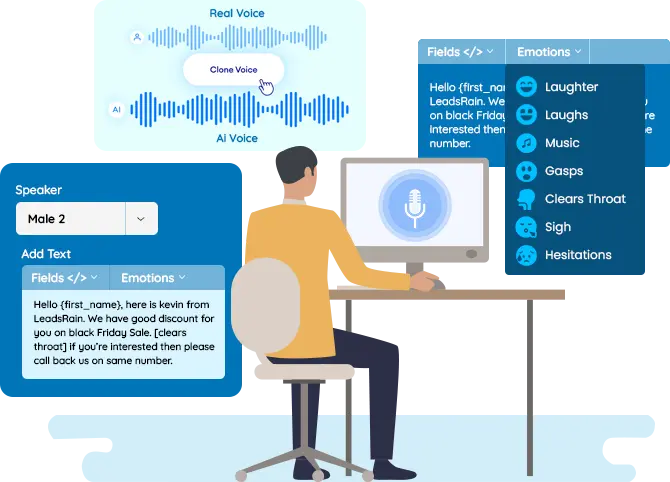In today’s fast-moving marketing world, every dollar spent must justify its return. That’s where ringless voicemail (RVM) shines: a tool that blends cost-efficiency with high engagement and proven results. But how do you measure its true value? This article will guide you through how to calculate ROI, what performance metrics matter most, and how RVM compares to traditional outreach methods like cold calling or SMS marketing.
Let’s break down how Drop.co’s RVM platform can become your best-performing channel.
What Is Ringless Voicemail, and Why Should You Care?
Ringless voicemail is a method of delivering pre-recorded voice messages directly into a recipient’s voicemail inbox without ringing their phone. It’s discreet, legal in many jurisdictions, and increasingly used across industries especially in marketing, real estate, finance, insurance, and political campaigns.
Why businesses love it:
- It doesn’t interrupt the recipient.
- It creates a more human connection than an SMS or email.
- It scales fast and costs far less than cold calling or live outreach.
Why ROI Matters: The Business Case for RVM
Return on investment (ROI) is the most important metric for evaluating a campaign’s success. Marketing teams need to prove performance, and sales teams need efficient outreach. RVM fits both needs by lowering acquisition costs and raising engagement.
With the right tracking, you can measure:
- Cost per lead
- Conversion rate
- Revenue per campaign
- Profit margins per message sent
Breaking Down ROI: Key Metrics You Should Track
To fully understand the performance of your ringless voicemail campaigns, it is important to track key performance indicators (KPIs) that reflect both engagement and profitability. These metrics will help you assess where your campaigns are succeeding and where there is room for improvement.
Delivery Rate
The delivery rate tells you how many of your voicemail messages were successfully delivered to your recipients’ voicemail inboxes. A high delivery rate is typically a sign that your contact list is accurate and that your messaging platform, such as Drop.co, is functioning efficiently. If delivery rates are low, it may indicate issues with your contact data or carrier filtering.
Why it matters: If your message never reaches the recipient, it has no chance to drive action. High delivery rates ensure that your investment in RVM is not wasted.
Listen Rate
The listen rate refers to the number of people who actually play and listen to your voicemail message after it has been delivered. This is one of the most direct indicators of whether your message is engaging or relevant to your audience. Advanced RVM platforms can provide data on message plays or use integrated call-back tracking to infer this metric.
Why it matters: High listen rates mean your message is getting attention. It shows that your audience is at least curious enough to engage with what you sent.

Response Rate
This metric measures how many recipients responded to your message after listening to it. Responses can include calling back, sending a text message, visiting a website, or taking another form of action prompted by your call-to-action. The response rate is a great indicator of how compelling your message is and whether it resonates with your audience.
Why it matters: Strong response rates usually correlate with well-crafted scripts, strong offers, and good timing. They also reflect trust and interest in your brand.
Conversion Rate
The conversion rate is arguably the most critical performance metric. It measures the percentage of responders who take a desired action, such as purchasing a product, booking an appointment, or signing up for a service. This is the number that directly impacts your bottom line and determines the real-world success of your campaign.
Why it matters: Response is good, but conversion is what brings revenue. Monitoring conversion rates helps you assess the overall effectiveness of your messaging strategy and value proposition.
Cost Per Lead (CPL)
Cost per lead is calculated by dividing the total cost of your RVM campaign by the number of leads generated. This metric is vital for comparing the efficiency of ringless voicemail against other marketing channels like pay-per-click advertising or traditional telemarketing.
Why it matters: RVM campaigns typically offer a lower cost per lead due to their low execution cost and high volume reach. Knowing your CPL helps in budgeting and campaign planning.
Revenue Generated
Revenue generated is the total income earned as a direct result of your campaign. This can be measured by tracking sales, subscriptions, donations, or other actions linked back to voicemail interactions. You should multiply the number of conversions by the average revenue per customer to determine the total financial return.
Why it matters: This metric provides the financial proof you need to evaluate whether your campaign is profitable. It is the foundation for calculating ROI.
Return on Investment (ROI)
Return on investment, or ROI, measures how much profit you made from a campaign compared to what you spent on it. It is calculated using the following formula:
ROI = (Revenue – Cost) / Cost x 100
For example, if your campaign costs 500 dollars and generates 5,000 dollars in sales, your ROI is:
ROI = (5000 – 500) / 500 x 100 = 900 percent
Why it matters: ROI is the ultimate measure of success for any marketing campaign. It helps you justify your marketing spend and identify which strategies bring the highest return.

Cost Comparison: RVM vs. Cold Calling – A Real-World Example
Imagine a home improvement company reaching out to 5,000 contacts through two different channels:
Ringless Voicemail Campaign
- Total Cost: $500
- Delivery Success: 95%
- Response Rate: 9%
- Conversions: 150
- Revenue: $7,500
- ROI: 1,400%
Cold Calling Campaign
- Total Cost: $3,000 (includes agents, time, tools)
- Reach Rate: 40%
- Response Rate: 3%
- Conversions: 40
- Revenue: $2,000
- ROI: -33.3%
Narrative Comparison:
The cold calling campaign required a higher investment in manpower and technology and returned far fewer conversions. In contrast, the RVM campaign was affordable, scalable, and delivered 3x the conversions with a much higher profit margin. RVM clearly provides better ROI when you’re looking to maximize reach while minimizing cost.

Pro Tips to Boost RVM ROI
Want to ensure your campaigns hit even higher performance benchmarks? Here’s how to do it:
1. Use Highly Targeted Lists
Start with clean, verified data segmented by interest, demographics, or behavior. The more relevant the recipient, the better the chance of conversion.
2. Personalise the Message
Avoid generic scripts. Use the recipient’s name, location, or prior purchase info to connect on a human level.
3. Run A/B Tests
Test different scripts, voice tones, lengths, and call-to-action variations. Over time, you’ll find the formula that gets the most callbacks.
4. Time Campaigns Strategically
Send messages at optimal times late mornings or early evenings often see higher listen and response rates.
5. Track Everything
Use Drop.co’s analytics dashboard or integrate with your CRM to track responses, conversions, and long-term customer value.
Industry Spotlight: Who Gets the Best ROI from Ringless Voicemail?
Real Estate Agents
- Announce new listings, open houses, or follow-ups.
- Often get 10–20% callback rates.
- High commission model = high ROI.
Insurance & Finance
- Great for policy renewal reminders, upsells, or portfolio updates.
- Replaces time-consuming manual calls.
- A single sale can cover the cost of a whole campaign.
Retail & Ecommerce
- Promote flash sales or abandoned carts.
- Voice creates urgency and builds trust.
Political Campaigns
- Notify voters, promote events, or encourage donations.
- Legal in many jurisdictions if opt-ins are respected.
- Reach 10,000+ constituents instantly for a fraction of traditional outreach.
Tools That Help You Measure and Improve ROI
Drop.co offers powerful features that make measuring ROI seamless:
- Real-time delivery and listen reports
- Tracking call-backs and site visits
- CRM and marketing automation integrations
- Custom campaign performance dashboards
These tools let you go beyond just tracking delivery you can measure actual business impact.

Common ROI Pitfalls (and How to Avoid Them)
Even the best tech can’t fix poor strategy. Avoid these mistakes to maintain strong ROI:
Mass-blasting without targeting
You’ll waste money on leads that will never convert.
No follow-up plan
One message isn’t always enough. Use RVM in a sequence with SMS, email, or call-backs.
Weak or vague CTA
Be specific. “Call us now to claim your free quote” works better than “Let us know.”
Not tracking results
If you don’t measure, you can’t improve. Always tie back RVM campaigns to outcomes in your CRM.
Sample ROI Calculation for a 5,000 Message Campaign
- Campaign cost: $500
- Messages delivered: 4,750
- Listens: 3,000 (63%)
- Callbacks/responses: 400 (13%)
- Conversions: 120 (3%)
- Avg. revenue per sale: $60
- Total Revenue: $7,200
- ROI = ($7,200 – $500) / $500 × 100% = 1,340%
This example shows how a small investment can yield massive returns when done right.
Why RVM Is the ROI King of Outreach
If your business depends on lead generation, outreach, or engagement, ringless voicemail should be a core part of your marketing strategy. It combines the scale of email, the personalisation of phone calls, and the efficiency of automation without the heavy cost.
Drop.co empowers businesses to reach thousands of prospects in minutes while tracking every step of the campaign funnel. From cost-per-lead to conversion-to-close, RVM gives you full visibility into performance and profitability.
Ready to Test Your Own ROI?
Try a ringless voicemail campaign on Drop.co today and see how a few hundred dollars can turn into thousands in revenue.
Let the numbers speak for themselves.
